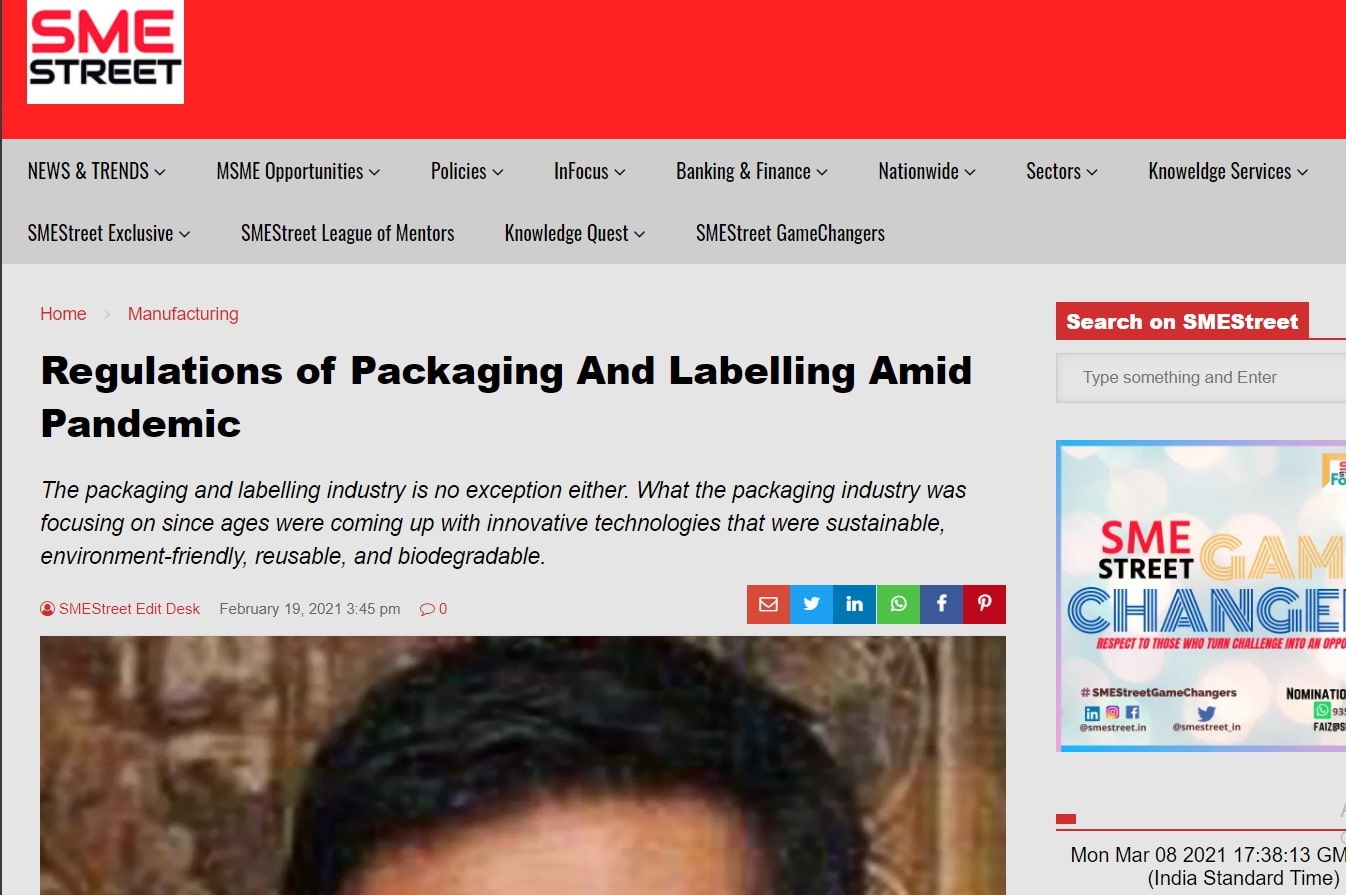How COVID-19 disrupted the packaging & labelling industry
The humanitarian impact of the infectious COVID-19 pandemic disease has dynamically changed the world. The outbreak of the pandemic has given a sledgehammer blow to a multitude of industries across the world. The packaging and labelling industry is no exception either. What the packaging industry was focusing on since ages were coming up with innovative technologies that were sustainable, environment-friendly, reusable, and biodegradable. But today, there has been a paradigm shift in their focus that brought safety concerns to the forefront of the consumers. Such changes threw a pool of challenges to the $900 billion per year global packaging industry. Today, the packaging industry in India is expected to witness a higher volume growth and reach a CAGR of 26.7% during 2021-2026 to USD 258.35 billion by 2026.
Labels that have been a part of the supply chains of the necessities and serving as a vital tool for conveying information severely faced local supply chain problems. It was mainly due to the discontinuation of paper production in India. The pandemic-infused fear led the consumers to become more aware of their purchased products after thoroughly checking what goes into them. Every country requires such information under consumer, product/environmental legislation, sector etc. to protect against fraud and counterfeiting.
Disrupted the packaging & labelling industry
Unlike other industries, the packaging industry has garnered significant benefits out of the COVID-19 pandemic. It brought a significant shift in the buying patterns of the consumers. The food packaging industry, being the largest area of activity of the packaging industry, all companies ensured a striking balance between sustainability and hygiene to prevail in the pandemic-infused crisis.
However, the COVID-19 lockdown has had a humongous impact on the labelling industry to reach a stand-still. Only a handful of label manufacturing companies were able to continue their operations with 20-25% of workers. As the majority of the label manufacturing companies were owned by the MSMEs, they were not accessed to a large pool of funds. It tried to put a brave front by well-bonding with other industry peers via social media platforms and telecommunications amid the pandemic. Their smooth functioning was disrupted by the shutting down of printers, suppliers, and customers for quite a while. Despite the obstacles, the labelling industry continued to provide services to the most essential things. The role of labels in pharmaceuticals, medical & hospitals, household & consumer goods, and food & drink sectors have been unparalleled during the pandemic. It is because consumers more likely checked the label information on product packaging during this period out of their safety concerns.
Here’s a roundup of the various consumer demands amid the pandemic from the packaging and labelling industry:
Demand for Packaged Foods
The Novel Coronavirus has offered a pool of opportunities, especially to the food packaging industry. Earlier, the majority of consumers in India preferred unpacked food that steadily changed after the outbreak of the pandemic. When other industries suffered, the demand for packaged foods, medicines, and hand sanitizers reached their peak heights. All these products required safe packaging, therefore, their production had been humongous than ever before. Consumers around the world started to prefer packaged food products over lose products like fruits, vegetables, biscuits, bread, sweets, dairy products, and other snacking options. When restaurants were shut down and consumers were sceptical about ordering food from outside due to hygiene concerns, these packaged food items became their saviour. Another major trend is ‘e-packaging’ that involves a minimum manhandling and offers a lower risk of adulteration and wastage due to spillage.
Food Safety & Hygiene Demand over Sustainability
The COVID-19 pandemic has made it transparent that food safety and hygiene are the fundaments to protect consumers from the disease. As the consumers’ sentiment significantly shifted to ‘safety & hygiene’ over sustainability, the packaging industry was left with no other alternative ways rather than changing its existing agenda. The pandemic has disrupted the packaging industry in specific areas like the increasing demand for digital printing, e-commerce, preference for food hygiene, and reviving the usage of single-use plastic. The pandemic brought plastic back to business as environmental concerns temporarily take a back seat. Single-use plastics are way safer, affordable, and long-lasting.
Tech-enabled Packaging Demand
With the ever-increasing number of COVID-positive cases, tech-enabled or smart packaging gained the maximum traction as it offers more transparency. Technology when incorporated directly to a product, it offers superior protection and knowledge to the consumers. Today, the packaging industry has implemented blockchain technology, QR codes, and smart labels that can be scanned for more knowing more product details. The packaging industry has successfully gained consumer confidence and loyalty by implementing smart packaging. It increases product protection, quality, supply chain productivity, and minimizes waste.
More demand for Transparent Labels
Labels of food products play a significant role in providing complete information to consumers. Consumers’ attitude towards knowing about detailed information regarding manufacturing & expiry date, ingredients, nutritional facts, contents information, product origin, size or weight, instructions for use, etc. have increased rapidly. Keeping in mind about the growing fear and concern of consumers regarding food hygiene during COVID-19, all manufacturers must provide minute details to them. Lack of transparent information on the package can negatively influence buyer decision and lead to decreased sales. They must provide allergic information on the label to inform the consumers about certain ingredients that may cause allergies.
Summing Up
Owing to the emerging concern about untouched and safe packaged food, the demand for safe packaging shall grow more intense in the future. In the pandemic-driven era, packaging and labelling go hand in hand. Both the industries should understand that the consumers demand transparent information on the package labels and keep safety in their top food priority list. It will undoubtedly continue even in the post-pandemic world.
The packaging and labelling industry is no exception either. What the packaging industry was focusing on since ages were coming up with innovative technologies that were sustainable, environment-friendly, reusable, and biodegradable.–SME Street




